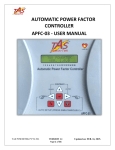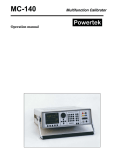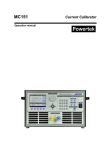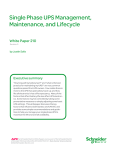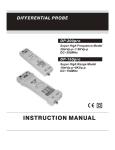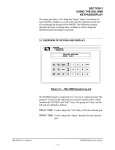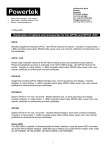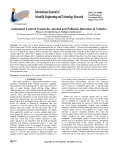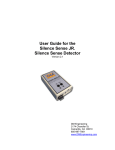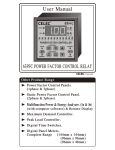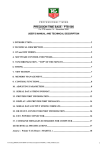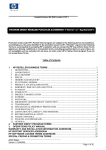Download APFC-05 in Manual
Transcript
Automatic Power Factor Controller
APFC-05
User Manual
Version 1.0
TAS POWERTEK PVT.LTD.
VERSION 1.0
Updated on: FEB. 18, 2015
Power Factor Controller APFC-05
NOTE
These instructions do not purport to cover all details or
variations in equipment, nor to provide for every possible
contingency to be met in connection with installation,
operation or maintenance.
Should further information be desired or should particular
problems arise which are not covered sufficiently for the
purchasers purposes, the matter should be referred to our
office.
The contents of this instruction Manual shall not become
part of or modify any prior or existing agreement or
relationship. Any statements contained herein do not create
new warranties or modify the existing warranty.
The reproduction, transmission or use of this document or its contents is not
permitted without express written authority. Offenders will be liable for damages. All
rights are reserved.
Because of continuous improvements efforts by TAS PowerTek in their Product’s Features and
Specifications, the Product as well as the content of the User Manual is likely to get updated.
Therefore, please always refer to the User Manual supplied to the customer along with the
Product, at the time of product dispatch.
CAUTIONS:
High voltage!
APFC may only be used indoor!
Make sure that the discharge time set in the controller matches the capacitor discharge time!
This User Manual for TAS APFC-05/xx Controller refers to the Firmware Version 1.0.0
Dated: 9th Jan. 2015.
TAS POWERTEK PVT.LTD.
VERSION 1.0
Updated on: FEB. 18, 2015
Index
Index page
-- 1
Features
-- 2
Specifications
-- 3
Mechanical dimensions
-- 3
Front fascia
-- 4
Back Side Terminals
--5
PF correction technique
-- 6 & 7
Typical wiring scheme
-- 8 & 9
Control wiring Scheme
-- 10
Rear side terminals
-- 11
Front Fascia LCD Screen Details
-- 12 & 13
Keyboard details
-- 14
Display of various parameters
-- 15
Sub menu for display of parameters -- 16
Method of Keyboard / Display usage -- 17 to 19
Keyboard / Display operations
-- 20 & 21
Edit Parameters
General & IO
-- 22
System
-- 22
Fault
-- 23 to 25
Steps
-- 26 & 27
Step utilization
-- 28
Commissioning Instructions
-- 29 & 30
Troubleshooting procedure
-- 31 & 32
Manufacturer’s Contact Details
-- 33
TAS POWERTEK PVT.LTD.
VERSION 1.0
-1-
Updated on: FEB. 18, 2015
Features
• Totally Micro-processor controlled Digital Signal processing
logic for measurements and control.
• Load V, I, odd harmonic coefficients up to 15th harmonic.
• Various modes for switching, viz:
Binary
Un-equal (user defined)
C-Series (preset series)
E-Series (user defined)
• Output banks control for either 4 , 6 or 8 Capacitor Banks.
• Standard 96x96 mm Plastic Cabinet for panel door flush
mounting.
• Protections provided:
Over/Under Voltage
Over / Under load current
Over Temperature internal to APFC-05 Unit
All these are user settable
TAS POWERTEK PVT.LTD.
VERSION 1.0
-2-
Updated on: FEB. 18, 2015
Specifications
•
•
•
•
•
Feed-back Voltage: 1-Phase, 2-Wire, 230Volt Ac, (+/- 10%)
AC Mains Supply Line Frequency: 50/60 Hz.
Current input: Selectable 1A or 5A for load.
Auxiliary Supply: 1-Phase, 230V (+/- 10%).
Correction time:
Selectable in Seconds from 1 Sec. to 65530 Sec.
• Output Commands: 4 (APFC-05/4) or 6 (APFC-05/6)
or 8 (APFC-05/8).
(Isolated ‘NO’ contacts of rating Inductive Load 0.5A/250Vac).
• Operating Temperature: 0 to +55oC.
• Storage temperature: 0 to +70oC.
• Relative Humidity: 10% to 95% (Non Condensing).
• AC Mains Supply frequency: 47Hz to 53Hz,or 57Hz to 63Hz.
91
Mechanical
dimensions:
96
91
96
100
All Dimensions
given are in mm.
Recommended size for cut-out on panel door is 92 x 92 mm.
Max. weight: (with clamps and terminals) = Approx. 0.6 Kgs.
TAS POWERTEK PVT.LTD.
VERSION 1.0
-3-
Updated on: FEB. 18, 2015
Front fascia
Keyboard, LCD display
LCD Display
LCD Display Contrast Adjustment
Slot for small Allen-Key, at the Top Surface
PF=0.98 IND A OK
Key pad
TAS POWERTEK PVT.LTD.
VERSION 1.0
-4-
Updated on: FEB. 18, 2015
BACK SIDE TERMINALS
•Auxiliary &
Measurement Voltage
Load Current CT
Output Terminals
TAS POWERTEK PVT.LTD.
VERSION 1.0
5
Updated on: FEB. 18, 2015
PF correction technique
Case-1: PF-UPPER & PF-LOWER both set as inductive:
PFLOWER.
PFLOWER.
kVAr
(Ind)
smallest
Capacitor bank
kVAr x 2 width.
PFUPPER.
PFUPPER.
- kW.
kW.
kVAr
(Cap)
No change band.
Capacitor addition band.
Capacitor removal band.
Case-2: PF-UPPER as Capacitive & PF-LOWER set as Inductive:
kVAr
(Ind)
PFLOWER.
smallest
Capacitor bank
kVAr x 2 width.
- kW
PFLOWER.
kW
PFUPPER.
PFUPPER.
kVAr
(Cap)
TAS POWERTEK PVT.LTD.
VERSION 1.0
- 6-
Updated on: FEB. 18, 2015
Case-3: PF-UPPER & PF-LOWER both set as Capacitive:
kVAr
(Ind)
smallest
Capacitor bank
kVAr x 2 width.
- kW
kW.
PFLOWER.
PFLOWER.
PFUPPER.
PFUPPER.
kVAr
(Cap)
No change band.
Capacitor addition band.
Capacitor removal band.
There are two PF set points to be set in APFC-05. The UPPER limit and
the LOWER limit. APFC-05 ensures that PF-UPPER is never exceeded.
Additionally, “No change band” to minimum kVAr band size equal to
smallest bank kVAr * 2 ensures no hunting during the low kW loading.
APFC-05 is normally set for PF settings as per first two diagrams shown
where PF LOWER is inductive. This philosophy helps to optimize the
system maximum kVAr to be used as well as reduces the number of
switching operations during higher loading conditions. This ensures better
life expectancies of the switched capacitors as well as the switching
devices.
This methodology of kVAr compensation reduces the complex settings
that are used by conventional PF relays. The settings like C/K ratio and
kVAr offsets/shifts are eliminated which makes APFC-05 user friendly and
thus easy to commission.
TAS POWERTEK PVT.LTD.
VERSION 1.0
-7-
Updated on: FEB. 18, 2015
Typical wiring diagram for PF correction
Scheme - 1
Load CT
HT side
L
O
A
D
LT side
Conventional LT side PF
improvement system
schematic
As per this scheme, the load sensing CT is put between
the source and the PF correction capacitor banks. This is
as per diagram shown above. The voltage feedback is
taken from the LT bus system itself.
This type of scheme is used when user is interested in
maintaining the healthy Power factor on secondary side of
the transformer.
This scheme is preferred with LT consumers of electricity,
where the metering is carried out on LT side.
TAS POWERTEK PVT.LTD.
VERSION 1.0
- 8-
Updated on: FEB. 18, 2015
Typical wiring diagram for PF correction
Scheme - 2
CT/PT on
HT side
HT side
LT side
L
O
A
D
LT Power Factor
compensation with HT
side feedback
As per this scheme, the load sensing CT is put at the input
of the transformer on HT side.
This scheme is preferred with LT consumers of electricity,
where the metering is carried out on HT side.
This scheme gives the compensation against magnetizing
current of the transformer. Thus, for HT metering able to
give more accurate results.
TAS POWERTEK PVT.LTD.
VERSION 1.0
-9-
Updated on: FEB. 18, 2015
Control wiring diagram
P1
P2
L1
S1
S2
L2
L
O
A
D
L3
N
Load
Current
L1
N
APFC-05
Either of the above specified schemes can be selected by
the user based on the system requirement.
TAS POWERTEK PVT.LTD.
VERSION 1.0
- 10 -
Updated on: FEB. 18, 2015
Rear side terminals – measurement
voltage, measurement current
Load CT Connection
Selectable 1A or 5A
Example: Select either
S1 ( 1A) or S5 (5A)
along with S ( common)
Auxiliary & Measurement
voltage Connection
COM
C1
S
S5
C2
S1
C3
C4
C5
C6
C7
C8
N
L1
230 V, 1Phase, 2Wire
Output commands to capacitor contactors.
APFC 05
COM = common,
C1…… C8 = potential free relays, maximum of up to 8 Stages,
0.5A, 230Vac, Inductive Load. F2 Fast-Blow Fuse Protected.
TAS POWERTEK PVT.LTD.
VERSION 1.0
- 11 -
Updated on: FEB. 18, 2015
Front fascia –
LCD screen, LED indications
PF=1.00 IND A OK
First line of display indicates the PF value, inductive / capacitive
PF, mode of operation and fault / OK status:
“PF = 1.00” indicates the overall PF of the system.
“IND” or “CAP” indicates if this PF is inductive or capacitive respectively.
“A” or “M” indicates the Auto and Manual mode of operation respectively.
“OK” (blinking) indicates status of the system, healthy or faulty.
Last two characters represent one of the following status:
OK
Controller status is okay
OV
Over voltage
VA
Measurement voltage is absent
UV
Under voltage
OD
Outputs are disabled
UT
Over internal temperature
OF
Over frequency
UF
Under frequency
Second line indicates the status of each capacitor bank by
symbols. The status is also shown by LEDs provided on the front
fascia. Following table gives the description of symbols & LEDs.
Symbol
Description
bank is in ON state.
bank is in OFF state.
bank is declared as FIXED & is in ON state.
bank is declared FAULTY & not available for use
output stage is not used in the system.
bank is in DISCHARGE mode (blinking red LED)
TAS POWERTEK PVT.LTD.
VERSION 1.0
- 12 -
Updated on: FEB. 18, 2015
Front fascia –
LCD screen
Example of a typical LCD display screen is show below:
PF=0.98 IND A OK
Meaning of this screen contents:
Total no. of banks connected is seven.
Power Factor at Load sensing CT is 0.98 ‘IND’ Inductive.
(‘CAP’ defines Capacitive).
Unit is operating in ‘A’ Auto mode. (‘M’ defines Manual mode)
Total number of banks that are operational are eight.
Bank no. 1 is declared as fixed and is in ON condition.
Bank nos. 2 and 3 are in ON condition.
Bank no. 4 is declared as faulty.
Bank no. 5 is in discharging state.
Bank nos.6 and 7 are in off state. Ready to be switched on.
Bank (output) no. 8 is not used / not connected.
TAS POWERTEK PVT.LTD.
VERSION 1.0
- 13 -
Updated on: FEB. 18, 2015
Front fascia –
Keyboard
Keyboard with soft touch keys are provided on the front facia
of the controller. The various keys are:
UP key. Used to scroll up the menu screen;
increment values when entering numbers.
Also used for changing the status of banks.
DOWN key. Used to scroll down the menu
screen; decrement values when entering
numbers. Also use to change status of bank.
RIGHT key. Used to shift the cursor to right;
also used to increase the contrast of LCD in
default display screen mode.
LEFT key. Used to shift the cursor to left;
also used to decrease the contrast of LCD in
default display screen mode.
ENTER key. Used for entering a submenu
or for setting up values.
PROGRAM key. Used for selecting modes
of operation and editing of parameters
MEMORY key. Used to save all changes
made in Edit Parameters menu.
TAS POWERTEK PVT.LTD.
VERSION 1.0
- 14 -
Updated on: FEB. 18, 2015
Display of various parameters
Values of various parameters can be viewed by using UP / DN
keys & then pressing ENT key. To exit a sub-menu press MODE.
PF=0.98 IND A OK
Overall values gives the average
values of system parameters – V, I,
kW, kVAr, kVA. Load side PF, kVAr,
kVA & frequency.
Display
Overall Values
Displays values of PF, kW, kVA,
kVAr.
Display
Power
Displays average values of THD for
V, I, harmonics up-to 15th.
Display
Harmonics
Displays the measured kVAr value
of each connected output step.
Display
Step kVAr
Displays the internal (cabined)
temperature.
Display
Aux-Function
TAS PowerTek India
APFC 05
TAS POWERTEK PVT.LTD.
This is factory set default display
screen giving information on PF,
mode, bank & controller status.
Displays the version of software.
VERSION 1.0
- 15 -
Updated on: FEB. 18, 2015
Sub menu for display of parameters
continued..
TAS POWERTEK PVT.LTD.
VERSION 1.0
- 16 -
Updated on: FEB. 18, 2015
Method for keyboard / display usage
Flowchart for entering into different modes:
PRESS
Enable
Default
Display
mode
If Password
Option is
Enable/Disable.
Disable
Enter Password:
****
PRESS
Enter the 4 digit
Password by using
& keys.
PRESS
NO
IF
PASSWORD
Correct?
YES
*
Continued on next page
TAS POWERTEK PVT.LTD.
VERSION 1.0
-17 –
Updated on: FEB. 18, 2015
*
1 2 3 4 5 6 7 8 9 10 11 12 13 14 15 16
Default
Display
mode
Select
1. Edit Parameter
Select
2. Auto Operation
Select
3. Manual Operation
#
Continued on next page
TAS POWERTEK PVT.LTD.
VERSION 1.0
- 18 -
Updated on: FEB. 18, 2015
#
Select
1. Edit Parameter
Select
2. Auto Operation
Select
3. Manual Operation
PF=0.98 IND A OK
PF=0.87 IND M OK
Operation in Auto
Mode.
Edit Parameters
General and IO
Edit Parameters
System
Operation in Manual
Mode.
General parameters
Grid / transformer / APFC
system related parameters
Edit Parameters
Fault
Fault trip settings
Edit Parameters
Step
Capacitor bank step settings
Edit Parameters
Utilization Cntr
TAS POWERTEK PVT.LTD.
VERSION 1.0
- 19 -
Banks utilization counter
Updated on: FEB. 18, 2015
Keyboard / Display operations
Mode Selection
There are two modes of operation (Manual and Auto) and one
mode for data entry (Edit Parameters).
Press the PROGRAM key. Enter password (if enabled) by using
keys. Press ENTER Now using keys, select the
Mode of operation:
• AUTO OPERATION
• MANUAL OPERATION
• EDIT PARAMETERS
Then press ENTER to enter the specific mode.
Auto Operation:
For functioning in automatic compensation.
Manual Operation:
Pressing ENTER button on this screen will put APFC-05 in
Manual mode. This mode would continue to run till it is
purposefully changed or power down occurs.
This mode is normally used to perform the operations like:
• Resetting of faulty banks to healthy status.
• Checking the Capacitor banks by turning them ON/OFF.
• Declaring specific bank/s faulty. Masking of the banks so that
once auto mode is selected, these faulty declared banks would
not be used for PF correction.
For Declaring banks faulty or Resetting faulty banks:
In manual mode default screen press ENTER key.
The cursor above bank 1 will start blinking. Use keys to
select the specific bank. Then use key to declare it faulty.
To reset the faulty bank, bring the blinking cursor to that bank
and use key again to declare that bank as healthy.
After any of these operations press ENTER key so that cursor
stops blinking. To save the status on permanent basis (so that
even after Power down, the status is unchanged), press
MEMORY key. After saving the settings, the unit will jump back
to default mode. (Default as Auto or Manual is set in Edit
Parameters).
continued..
TAS POWERTEK PVT.LTD.
VERSION 1.0
- 20 -
Updated on: FEB. 18, 2015
…continued.
For Testing banks with manual ON / OFF commands:
Press ENTER key, the cursor will start blinking. Use keys
to select the specific bank/s that are healthy and use key to
turn ON and use key to turn OFF that capacitor banks.
To come out of Manual ON/OFF edit mode, press ENTER key so
that cursor stops blinking.
Edit Parameters:
This mode is used to carry out system settings. In this mode
various system settings can be carried out. To do the same,
use the keys and select the type of parameters to be
edited. The types of parameters that can be edited are:
General & IO
: For general settings.
System
: For mains/generator system settings.
Fault
: Fault settings.
Step
: Capacitor bank step settings.
Utilization counter: Bank operations utilization counters.
After selecting the type, press ENTER to enter the sub-menu of
that specific type.
The details of these sub-menus for every type is given further.
You can edit all these sub-menu settings by using the ENTER,
, , , and keys
To come out of the sub-menu press PROGRAM key once.
To store the edited parameters permanently, press SAVE when
you are either in the Edit Parameters or any sub-menu area.
To come out of Edit Parameters without saving the changes
press PROGRAM key again.
Note: In the Edit Parameters area, if no keys are pressed for
more than a minute, the default display screen comes on and
the changes done till that time are discarded.
TAS POWERTEK PVT.LTD.
VERSION 1.0
- 21 -
Updated on: FEB. 18, 2015
General & IO
PASSWORD
Enable
:1
CHANGE PASSWORD
: 0001
LOAD DEFAULT
No
:0
THD TO DISPLAY R/F
F-THD
:1
Password: Enable or disable password.
Value: 0=Disable, 1=Enable.
Change Password: Set new value of password (4
digit). Factory default password is “0000”
Load Default: Loads factory set default parameters.
0=No, 1=Yes.
THD to Display: Type of THD to be displayed for V, I.
Unit ID: Allows Users to assign a Unique, 4-Digit
Identification Number to this APFC Unit.
UNIT ID
0000
System
Meas. Voltage
: 240
EXT-PT Ratio
0001.0:1
CUR CT Primary
Mains
: 1000
PF Up Lim :
[Ind :1]
Mains
0.980
PF Up Lim: Mains
Ind : 1
[0.980]
PF Low Lim: Mains
[Ind :1] 0.970
PF Low Lim: Mains
Ind :1 [0.970]
Auto kW Polr Chk
Disable: 0
Measured Voltage: Factory set parameter dependent
on hardware. For viewing only.
Ext-PT ratio: By default set to 0001.0:1, but in case
external PT is used, this ratio can be set. Limits:
Lower: 0000.1 Upper: 6000.0
Cur CT Primary: (Mains ): Feedback
source current for mains (if used with summation
CTs). Limits: Lower: 0001 Upper: 9999.
Power Factor Limits: APFC-05 has one set point for
Mains. upper & lower limits can be defined as Upper
PF and Lower PF. PF limits can be set as inductive or
capacitive.
Auto kW Polr Chk: Allows user to correct the kW
Reading to a Positive Value to indicate Energy
“Import” without reversing the CT Polarity in case
the kW reading is a –Ve value.
continued..
TAS POWERTEK PVT.LTD.
VERSION 1.0
- 22 -
Updated on: FEB. 18, 2015
Fault
Over voltage flt
Disable
:0
Over voltage
Limit
:115%
For most of the types of faults defined here, the options
available are as hereunder:
0=Disable
1=Indicate (Display a Fault Message & or store in Flash)
2=Off Step (Switch off Non Fixed Steps one by one)
3=Off Fixed Step Also (Switch off All Steps one by one)
4=Fast Off Step (Switch off all Steps in one shot)
Over voltage
Resume
:110%
Under voltage flt
Disable
:0
Under voltage
Limit
:085%
Under voltage
Resume
:090%
Over load flt
Disable
:0
Over load
Limit
:130%
Over load
Resume
For all the faults, normally two limits are defined. One is
Detection Limit and another Resume Limit. Detection
Limit if exceeded by the parameter would mean the action
as defined by parameter in type of fault (as given hereabove). Resume Limit defines the parameter value below
which the fault is deactivated.
• Over Voltage: As name suggests, its for Over-Voltage
conditions.
• Under Voltage: For Under-Voltage conditions.
• Over Load: If APFC-05 detects the supply system is
overloaded, then it is sometimes recommended to remove
the capacitors out of circuit to reduce the fault current
levels. Under such circumstances this parameter is set.
Alternately, it can be set to Indicative.
• Under Load fault: The values here are set as % of
Maximum rated KW. This is useful in case of banks are
put in circuit to take care of no load compensation. Value
for this Under-Load KW can be calculated as shown here.
:125%
Under load flt
Disable
:0
Under load
Limit
:020%
Under load
Resume
:025%
continued..
TAS POWERTEK PVT.LTD.
VERSION 1.0
- 23 -
Updated on: FEB. 18, 2015
kVAr
(Ind)
Under Load settings:
PFLOWER.
1.25 x smallest
Capacitor bank
PFUPPER.
kW.
kW
UnderLoad.
No change band.
Capacitor Addition band.
kVAr
(Cap)
Capacitor Removal band.
For PFUPPER Inductive and PFLOWER Inductive :
1.25 x Smallest bank kVAr.
Under-Load kW value setting =
[tan{cos -1(PFLOWER)} – tan{cos-1(PFUPPER)}]
For PFUPPER Capacitive and PFLOWER Inductive :
1.25 x Smallest bank kVAr.
Under-Load kW value setting =
[tan{cos -1(PFUPPER)} + tan{cos-1(PFLOWER)}]
For PFUPPER Capacitive and PFLOWER Capacitive:
1.25 x Smallest bank kVAr.
Under-Load kW value setting =
[tan{cos -1(PFUPPER)} – tan{cos-1(PFLOWER)}]
TAS POWERTEK PVT.LTD.
VERSION 1.0
- 24 -
Updated on: FEB. 18, 2015
…continued.
Int Temperature Flt
Disable
:0
Temperature
Resume
: 55 Deg C
Temperature
Limit
: 65 Deg C
Step Health Chk
Disable : 0
Bank KVAR Fault
Tolerance
:10
Bank KW Fault
Tolerance
Internal Temperature Fault: Unit monitors the
temperature inside the APFC 05 housing. This
temperature can go up either due to ambient temperature
in the APFC panel has gone up beyond limit or if some
component failure in APFC-05 hardware itself. Upper limit
is for tripping and lower limit is for normal operation
(resume).
• Step Health Check : APFC 05 carries out on line
monitoring of the kVAr values of every step. This is when
the step is put in the tolerance limit defined here is
exceeded, that specific bank is declared faulty.
:10
TAS POWERTEK PVT.LTD.
VERSION 1.0
- 25 -
Updated on: FEB. 18, 2015
Step
Steps connected
: 08
Default mode
Auto
:0
Compensation kVAr
Mean
:1
Cap Bank Voltage
0415 V
Correction Time
Seconds
:00010
Discharge Time
Seconds
:00060
Step Response Time
Cycles
: 00045
Fix-Bank Setting
________
Bin/C / E Series Bank kVAr
: 200
Ext Fix Bank
KVAr : 000
Correction Type
C Series
:2
C – Series : 00
11111111111111
E - Series
1488888888888888
Unequal Bank [1]
KVAr = 050
Unequal Bank [2]
KVAr = 050
Unequal Bank [3]
KVAr = 050
Unequal Bank [4]
KVAr = 050
Unequal Bank [5]
Steps Connected: Defines the number of steps
operational. Depending on PF system banks, this
parameter is set.
• Default Mode: 0: Auto and 1: Manual. This parameter
defines the mode during Power up. (Default is 0: Auto)
• Compensation kVAr: 0:Instantaneous & 1:Mean.
Defines the method for kVAr compensation. If it should be
instant at which the compensation is made or it is mean
of kVAr that is required from previous compensation to
present compensation.
• Capacitor Bank Voltage: Capacitor bank voltage line to
line value is defined here. i.e. it defines the Voltage value
at the defined kVAr.
• Correction Time: Defined in seconds. This is the Time
between two consecutive kVAr compensations.
• Discharge Time: Time defined here is the time for
discharge of the capacitors to a level, so that they can be
turned ON again.
• Step Response Time: Defines the time after which the
kVAr of any step should be measured when the step turns
on .
• Fix-Bank Setting: Defines the banks that are to be
declared as fixed. These banks even in spite of
overcompensation cannot be turned OFF. The banks can
only be turned OFF under fault conditions. (if settings in
fault are defined).
• Correction Type: APFC-05 can have bank configurations
that are defined by four various methods. 0=Binary,
1=Unequal, 2=C Series, 3=E Series.
Binary is in ratio of 1:2:4:8:16---.
Un-equal is used with banks not having definite ratio.
C series is predefined Control Series. The standard
ratios are preloaded in APFC-05 that can be selected here.
E series is User defined Control Series. The bank ratios
that are not defined in C series can be defined here.
Digits can be 1,2,-- 9,
KVAr = 050
Unequal Bank [6]
KVAr = 050
Unequal Bank [7]
KVAr] = 050
Unequal Bank [8]
continued..
KVar = 050
TAS POWERTEK PVT.LTD.
VERSION 1.0
- 26 -
Updated on: FEB. 18, 2015
…continued.
• C Series: Various control series (C Series) can be selected
00: 1 1 1 1 1 1 1 1 1 1 1 1 1 1 1 1.
01: 1 2 2 2 2 2 2 2 2 2 2 2 2 2 2 2.
02: 1 2 3 3 3 3 3 3 3 3 3 3 3 3 3 3.
03: 1 2 3 4 4 4 4 4 4 4 4 4 4 4 4 4.
04: 1 2 4 4 4 4 4 4 4 4 4 4 4 4 4 4.
05: 1 2 3 6 6 6 6 6 6 6 6 6 6 6 6 6.
06: 1 2 4 8 8 8 8 8 8 8 8 8 8 8 8 8.
07: 1 1 1 1 2 2 2 2 2 2 2 2 2 2 2 2.
08: 1 1 1 1 1 6 6 6 6 6 6 6 6 6 6 6.
09: 1 1 2 2 2 2 2 2 2 2 2 2 2 2 2 2.
• E-Series: As explained earlier, this series is the user defined series.
Digits can be adjusted from 1 to F i.e. 1 to 15.
• C/E/Bin Series Bank kVAr: The kVAr defined here is the capacitor bank
KVAR of the smallest bank i.e. the value defined by digit ‘1’ in C series, E
series or Binary.
• Unequal Bank kVAr [1….8]: If unequal kVAr bank configuration is used,
these parameters are to be defined for every bank kVAr (at defined
Capacitor Bank Voltage). APFC-05 has a in built intelligent algorithm to
select the best possible combination to suit the exact kVAr requirement
for compensation.
TAS POWERTEK PVT.LTD.
VERSION 1.0
- 27 -
Updated on: FEB. 18, 2015
Step Utilization
Utilization cntr: Bank n: This gives
the number of ON/OFF operations of
the “n”th bank.
• Reset Utilization Counter: Bank n:
Options are “Yes” and “No”.
Declaring specific bank number with
Yes and pressing save command will
reset the specific bank utilization
counter to zero. This is normally
done in case the specific bank is
replaced with the new one.
TAS POWERTEK PVT.LTD.
VERSION 1.0
- 28 -
Updated on: FEB. 18, 2015
Commissioning Instructions
Before panel is powered up for the first time
1. Panel Wiring Check
Ensure that all connections in the panel is tightened properly
and there are no loose connections. Also ensure that the
wiring is done as per the wiring diagram.
2. Power Wiring Check
Ensure that the power cables are connected properly from the
Panel I/C to the feeder I/C or the transformer bushings. The
connection has to be after the Load Feed back CT looking from
the Transformer side.
Ensure that the Bus Bars and/or Lugs are clean and free of
Dust, Corrosion or Oxidation on the contact sides so that good
electrical connection is maintained. The surface area should be
flat so as to get maximum contact area.
If required Clean the Bus Bars and/ or Lugs by rubbing it with
Polish Paper to remove the oxidation layer. Provide contact
paste in between the contacts surfaces.
Not performing this, can result in to a weaker source point for
Capacitor charging during Step on and this can generate
undesirable Noise which can hamper the performance of
equipments installed in the capacitor panel.
3. Load Feed Back CT connection
Ensure that the load feed back CT connections are done
properly. Confirm that correct phase CT is connected with the
correct phase input terminals.
CT connections to be done carefully so as to ensure that the
wire does not get open and there is no loose connection.
Loose connection or open CT secondary can result in very high
voltages getting developed in the circuit which can damage
the CT and also produce high levels of noise in the system.
TAS POWERTEK PVT.LTD.
VERSION 1.0
- 29 -
Updated on: FEB. 18, 2015
After panel is powered up
• Remove the fuses/switch off MCBs/MCCBs which are in series with every
capacitor bank. Connect supply to the APFC-05. Keep the load feedback
current feedback in shorted condition.
• Turn ON the supply to the panel and set the various parameters as per
the panel configuration. It is important to understand the meaning of
every parameter from the instructions given before and then put the
appropriate values in them. Wrong values entered can give the wrong
performance of the panel.
• Once the parameterization is complete, put the APFC-05 in Manual mode
to check every bank command is transmitted to the switch. This can be
observed by turning ON the contactor coil supply MCB on. The
corresponding output should be checked for physical turn ON / OFF of the
contactor.
• Once all the contactors are seen to be getting the correct commands,
switch off the supply to the panel and replace all the fuses (or turn on
MCBs/MCCBs if they are provided instead of fuses). Turn on the panel.
5. Put APFC-05 back in Manual mode and turn ON/OFF the individual steps.
Use Tong tester (ac current measurement) to check that current in all
three phase of the corresponding bank are OK. In case any bank is not
giving the desired current, check for capacitor bank healthiness or power
circuits.
6. Keep all the banks in off mode. Remove the short of Load feedback CT. In
case kW value is seen as –ve , CT is with wrong polarity.
7. Now turn ON the capacitor banks one by one and observe that capacitor
current increases as per the rating of the steps on capacitor Current
display. Turn ON all the banks to see that almost full rated current flows
through the capacitors.
8. Switch OFF all the banks manually and put the APFC-05 in Automatic
mode. Switch Off the supply to panel and put it ON. APFC-05 will first
turn ON all the capacitor banks and turn them off.
Observe panel performance for about 2 Hours after commissioning.
TAS POWERTEK PVT.LTD.
VERSION 1.0
- 30 -
Updated on: FEB. 18, 2015
Troubleshooting procedure
Nature of Fault
Probable Reason
Action to be taken
Unit does not
turn ON.
•Input auxiliary supply
not coming.
•Input side fuses
blown
•Check the input
supply & restore.
•Check fuses in the
unit are OK.
Unit does not
turn ON any
capacitors even
if PF is below
Lower PF limit.
The load kW is too
low.
• Control connections
from RLY module to
contactor coils are not
proper.
•This is expected
condition.
•Check control supply
and connections from
RLY to contactors.
Some Capacitor
banks are
declared as
faulty even if
they are checked
to be OK.
•Individual step health
monitoring is enabled
and tolerance limits set
are too stringent.
• Capacitor current
THD factor is
continuously
fluctuating.
•Set the tolerance
limits for individual
steps monitoring
appropriately.
• With continuously
fluctuating THD of
Capacitor current and
higher level of THD
can cause some errors
in individual step kVAr
measurement. Under
this condition, best is
to keep this feature
disabled.
continued..
TAS POWERTEK PVT.LTD.
VERSION 1.0
- 31 -
Updated on: FEB. 18, 2015
Troubleshooting procedure
… continued
Nature of Fault
Probable Reason
Action to be taken
APFC-05
• The contactor supply
phase may be the
same as used for
APFC-05 auxiliary
supply.
• R-C Snubbers or
MOVs for AC Circuits
or free-wheeling
diodes for DC Circuits
are not put with
contactor coils.
• Use the different
phase for control
supply of contactors
and for APFC-05
supply
• Usage of R-C
Snubbers or MOVs /
free-wheeling diodes,
across the Contactor
Coils is mandatory.
resets
occasionally on
turning OFF of
any contactor.
TAS POWERTEK PVT.LTD.
VERSION 1.0
- 32 -
Updated on: FEB. 18, 2015
Manufacturer’s Contact Details:
The Sales & Marketing / The Customer Support & Service Dept.,
TAS PowerTek Pvt. Ltd.
W-61, C/o. Pawar Industries, Opp. “Machine House”,
Ambad MIDC Industrial Area,
Nasik – 422 010 (via Mumbai),.
Maharashtra State, India.
Land-Line Phones: +0091-253-6694956 (Sales & Marketing).
+0091-253-6694955 (Customer Support &
Service).
Fax: +0091-253-6694 955.
Working Hours: 9:30 AM to 6:30 PM. Weekly Off: Saturdays.
E-mail: [email protected]
Web: www.taspowertek.com
This Product is completely Designed, Developed,
Manufactured,Assembled, Tested, and Calibrated in India by
TAS PowerTek Pvt. Ltd., Nasik – 422 010, India.
- 33 -
TAS POWERTEK PVT.LTD.
VERSION 1.0
Updated on: FEB. 18, 2015




































